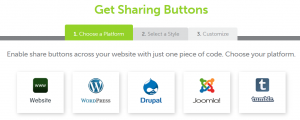- Aug 25, 2016
 0
0- by A2 Marketing Team
Being the owner of an outdated website can result in a lot of headaches. If your site doesn’t have a modern look, visitors may get all sorts of funny ideas about your business, which could impact sales.
Visiting an outdated website is like taking a trip down memory lane. While the experience can be charming, more often than not it’s better to let go of the past, tear things down, and redesign everything from scratch.
In this post, we’ll offer up some tell-tale signs your site is in need of a spruce up, while giving you advice on how to put it right. Let’s get cracking!
1. High Bounce Rates
Despite the funny moniker, high bounce rates are no laughing matter. When we talk about bounce rates, we’re referring to the percentage of visitors that bolt after seeing your homepage, without interacting with it. It’s the web equivalent of running away after seeing your date arrive before they take a look at the menu.
There are many reasons for a high bounce rate, including an unappealing design. If your site has looked the same for a while, it’s possible that visitors will find it clunky, unattractive, and untrustworthy – meaning they may not want to engage with it at all.
To fix this, you’ll need to start by catching up with the latest web design trends. Knowing this will give you an idea of what audiences currently want and expect, and will serve as a source of inspiration for your new design.
You may also opt to use a Content Management System (CMS) such as WordPress in conjunction with a modern theme such as Avada, which makes it easy to build attractive websites.
Once you’ve figured out what works for you in terms of design, consider employing A/B testing techniques to reduce those rates even further.
2. Long Loading Times
It’s no big deal if your website takes a few seconds to load in its entirety, right? Wrong. Users are notoriously impatient when it comes to loading times, and even a couple of extra seconds can have a significant impact on your bottom line.
Outdated designs can result in long loading times for many reasons, such as using unoptimized media elements (such as images and animations), annoying flash videos, and outdated technologies in general.
To fix this, firstly measure how severe the problem is. To this end, there are several tools you can employ to measure your loading times down to the millisecond, such as Google’s PageSpeed Insights.
Once you know exactly how long your site takes to load, move on to optimizing its media assets. We recommend running images through a tool such as TinyPNG, which also comes in plugin form for WordPress users.
Additionally, you might want to implement a caching solution or Content Delivery Network (CDN) for your site using a free service such as CloudFlare, although there are plenty of other alternatives out there.
If you want to read about more techniques for reducing your loading times, check out this guide covering nine different methods. Meanwhile, if you’re a WordPress user looking for a platform-specific guide, check out The Ultimate Mega Guide to Speeding Up WordPress.
3. Poor Mobile Optimization
This may come as a shock to some of our readers (especially those who have forsaken civilization during this past decade), but mobile devices are pretty popular these days. If a site isn’t responsive, it’s likely that it hasn’t been updated for a while.
Online shoppers now prefer shopping via mobile devices rather than desktop machines, and in general, visitors eschew sites that aren’t mobile-friendly. Suffice it to say, if your site doesn’t play well with mobile, you’re going to feel the consequences.
Thankfully, creating a mobile optimized website these days isn’t the herculean task it was in years gone by. Nowadays, there are plenty of relatively simple web development frameworks that are built to play nicely with multiple resolutions, such as Bootstrap and Foundation.
If you’re not giddy about the prospect of dealing with code you can always turn to WordPress, which offers a myriad of high-quality responsive themes to choose from.
Finally, you might also want to run your website past Google’s Mobile Website Speed Testing Tool, which provides you with actionable advice on how to improve its responsiveness.
4. Outdated Content
As we’ve already established, outdated content can be a huge turn-off for your visitors. So far we’ve only talked about old designs, but stylistic choices aren’t the only concern when it comes to outdated content. Having the wrong contact information, displaying old images and videos, utilizing intrusive media files (think pop-ups and videos set to autoplay), and choosing outdated fonts all can stand to cause you trouble.
These might seem like small details, but paying attention to these is critical when putting together a modern website that visitors feel they can trust.
Once you undertake your site’s redesign, you must go over every aspect of it with a fine-tooth comb to make it all the more attractive (and easy to use) for your visitors. Keep your contact information up to date, update old pictures and videos to reflect the evolution of your services, get rid of intrusive media, and select a modern, readable font for your posts.
5. No Social Media Options
Let’s face it – everyone spends far too much time on social media platforms nowadays, and every business is expected to have at least some sort of presence on them. If you haven’t set up social media accounts on your website – or at least included social sharing options for your posts – visitors may rightly think that you’ve fallen behind on the times.
The good news is that you don’t need to create accounts on every single social media platform. If you’re savvy, you’ll find out where your audience is most active and focus your efforts on those platforms. Knowing who to target is the first step on the journey to developing a successful social media strategy.
Furthermore, implementing social media sharing is pretty simple nowadays. For example, ShareThis enables both regular websites and those powered by WordPress to implement sharing buttons on their pages without too much fuss:
Conclusion
Renovating your website doesn’t necessarily have to be a traumatic experience. Think about it as an opportunity to start from scratch, armed with better tools and services than were previously available. It might take some time, but your future visitors will thank you for it.
In this post, we’ve offered five signs that you should redesign your website, and how to implement them. Let’s recap:
- Reduce your bounce rate by implementing a modern design.
- Cut down on long loading times by optimizing your images, and implementing a caching solution.
- Optimize your design for mobile displays.
- Make sure your site is free of any outdated content.
- Focus on the right social media platforms and include sharing options.
Image credit: PublicDomainPictures.


















